
 |
| STLabs, an ATARI 16/32 computers hardware lab! |
|
for the ATARI MEGA STE computer. |
MSTEIDEM (Mega STe IDE Memory)
CARD
FEATURES
in any case, a 64K area is
reserved for a BIOS-like bootloader
STATUS
|
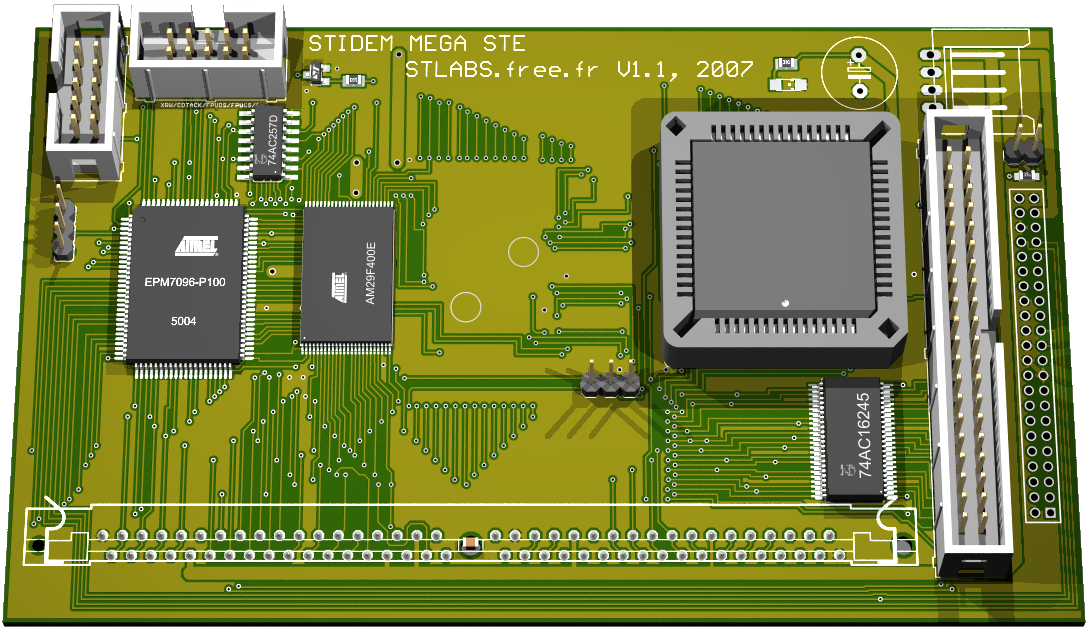
| TEST
\ MACHINE |
MEGA
STE 8MHZ 4MB B&W BLITTER |
MEGA STE 16MHZ+BLITTER+CACHE | MEGA
STE + STIDEM 16MHZ+BLITTER+CACHE+FAST-RAM (TOS+CPU 16MHz) |
| BOGOMIPS |
0.78 |
1.73 |
1.75 |
| HDDRIVER
8.18 READ
WRITE
MULTIREAD MULTIWRITE |
DMA
SCSI SEAGATE 1.15 MB/s 1.06 MB/s 0.93 MB/s 0.76 MB/s |
ACSI
DMA SCSI SEAGATE 1.17 MB/s 1.10 MB/s 0.95 MB/s 0.76 MB/s |
IDE
COMPACT FLASH 1.7 MB/s 0.67 MB/s 1.52 MB/s 0.93 MB/s |
| CPU MEMOREAD
MEMOWRITE BLOCKMOVE BITSHIFT MULDIV OVERLAP RAWPOWER VIDEOREAD VIDEOWRITE MEMOREAD FASTRAM MEMOWRITE FASTRAM |
2.40 MB/s 2.40 MB/s 1.43 MB/s 0.44 Minst/s 111 Kinst/s 0.95 Minst/s 1.90 Minst/s 1.50 MB/s 1.50 MB/s - - |
2.45 MB/s 2.45 MB/s 1.48 MB/s 0.98 Minst/s 200 Kinst/s 1.94 Minst/s 3.88 Minst/s 1.60 MB/s 1.60 MB/s - - |
2.48 MB/s 2.48 MB/s 2.92 MB/s 0.98 Minst/s 237 Kinst/s 1.96 Minst/s 3.86 Minst/s 1.6 MB/s 1.6 MB/s 4.92 MB/s 4.92 MB/s (+100% againt ST-RAM) |
| February 2007 A new debugged PCB was sent for fabrication in China, I am waiting for 5 cards back. I created as new page for the Mega ST version which is a prototype, see here I do not consider a ST/STE version for now as it requires real hands-on capabilities for the end-user. Although the MSTEIDEM card is electrically compatible with an ATARI ST or STE , it is physically not. The old PCB picture is moved hereafter first MEGA STE prototype 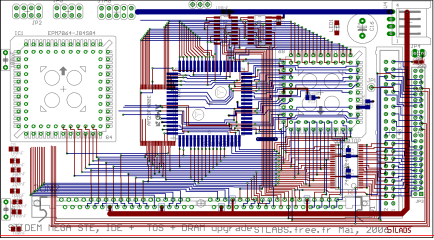 ST/STE placement, never layouted nor produced 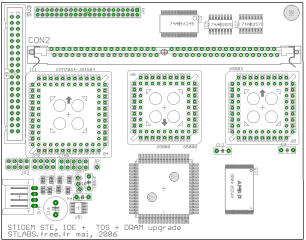 |
May 2006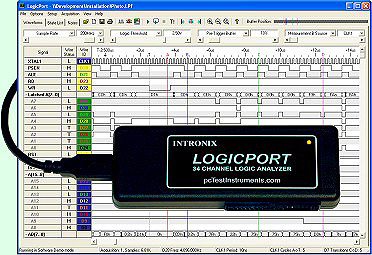 No, I am not dead ! I indeed recently purchased a portable logic analyser to be able to hack the card at home Since the design had been sleeping for months, I mostly re-started from scratch the logic part and step by step included flash, ide and dram. The 5V programmable logic chip is definitely too small for a PS/2 interface which is abandonned. Further investigations are made to integrate a Microchip PIC to interface a PS/2 mouse. |
| June 2004, 20th Card fabricated and in debug phase ! I received the fabricated prototype begining of June. A long and rather tuff debug phase is started !! The card works for now with a 8MHz CPU, no cache, no blitter. Among the news : - I had to fix a wrong connection to the flash memory (blue wire on the picture) but now the 512 KB flash ROM is working 100% ! I was able to emulate a cartridge port of 256K (yes not only 128KB but 256K !) and put software in it that is seen by the TOS as drive c. I also flashed the 256KB TOS 2.06 so I can even skip the original ATARI roms!. And last but not least I started to integrate EMUTOS as a replacement for the ATARI TOS. I currently have to go deeply into EMUTOS since it is crashing at book and have to make out wether it is related to my hardware or probably to the fact that I appear to be one of the first EMUTOS users on a real MEGA STE since years. - IDE is working with two very old 80MB and 600MB drives and I want to test a CD-ROM - TT RAM is underway. I was able to perform refresh, read and write cycles on the even addresses and have to work further for a fully working additionnal memory That's all for now and there is enough work for weeks before I can achieve full fonctionnality and 16MHz/cache/blitter support and go further on PS/2 mouse and keyboard interfaces. 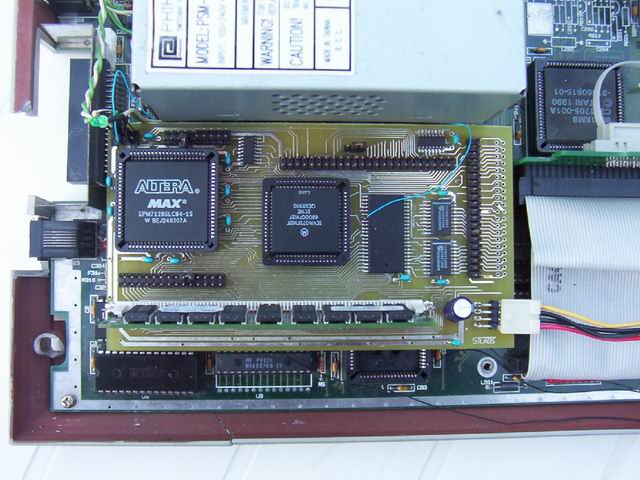 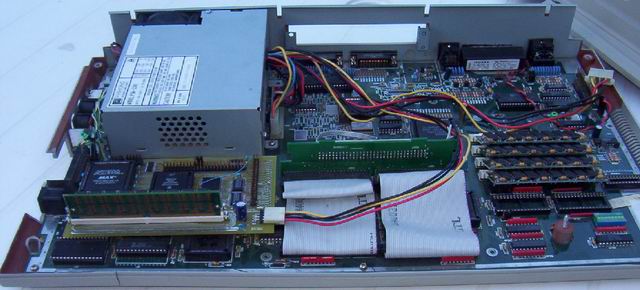 |
| May 2004, 18th Hi! after months of low activity, i finally manageg to finish the PCB layout of the card !! It was sent for production of two prototypes boards which I have to populate with hand soldering! The samples are to come back on may 28th, 2004. Among the changes, I have picked up the 68000 main clock so that I can try overclocking (is 32MHz reacheable?) and have routed the pin header to connect both a PS/2 mouse and PS/2 keyboard. The design of the RTL code for the mouse is already done, though untested. 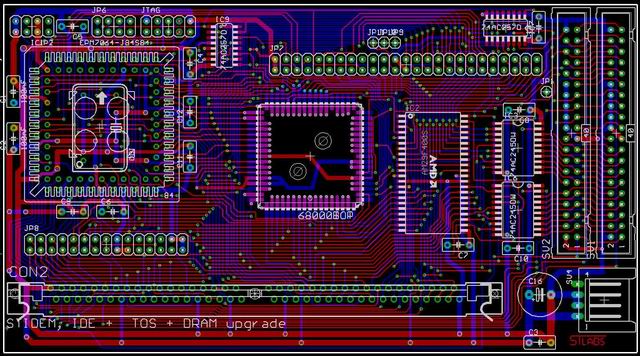 |
| December 2003, 13th Work in ongoing well, but far from lightspeed ! Among the changes, I droped the internal compact flash connector for a second IDE connector so that a flat cable can externally connect a compact flash through a suitable adaptor. I added a Falcon-like 68000 BUS connector, which I hope I can keep despite layout density problems. Some more small connectors shall allow the connection of a PS/2 mouse including mouse wheel ! The hardware as well as software drivers for that are not written yet. The layout of the board is the last phase before production, but a two-layer only PCB is a real challenge. 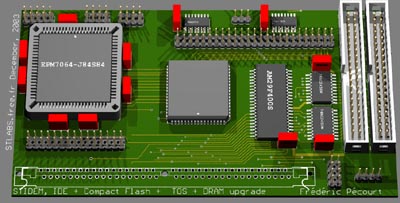 |
| August 2003, 28th The logic to address the IDE interface as well as the memory controller are written. This latter requires to pick up a 32MHz clock from the mainboard. The TOS/flash controler with embedded flash write capability is still to be developped. I made a major decision not to plug the card into the original STE ROM sockets any more. Instead I plan to plug it solderless on top of the PLCC 68000 microprocessor of the STE, thus elliminating 95% of the soldering previously required. In a first step, the card shall directly plug on a STE second revision which have soldered 68000s. In a further step, I want to find a socket adaptor for the first series of STE and MEGA STE. |
 |
| July 2003, 26th STIDEM - IDE and alternate Memory Upgrade for ST I have now started the first project, which will feature : - an on board 512Kb flash ROM allowing biTOS operation (like 1.4 and 2.06 or 1.6 and 2.06) - an IDE and a sexy Compact flash interface for a silent ST with harddisk! - an alternate memory upgrade (TT-RAM/Fast-Ram) up to 10Mb on top of ST-RAM Here is a 3D view of the status of the board which is not frozen yet! Missing is also the layout of the connections as well as the code for the logic to be programmed in these chips. 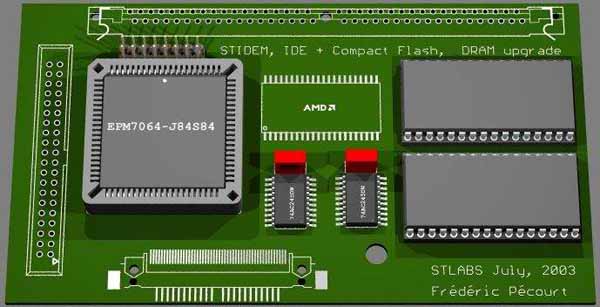 |